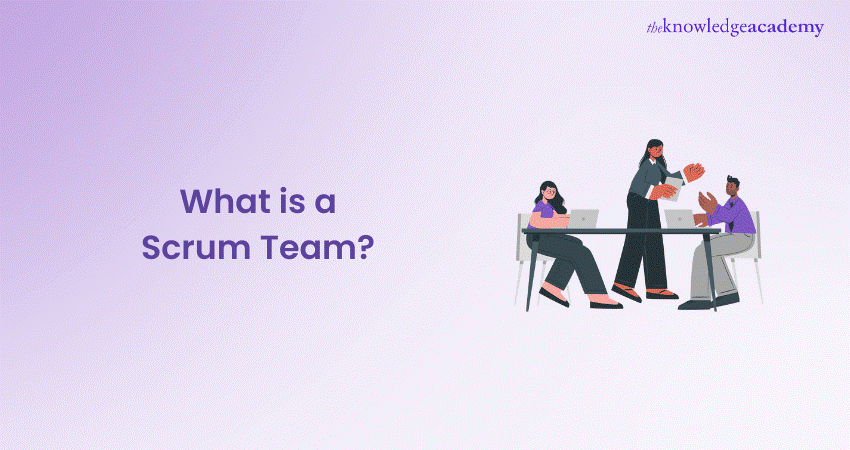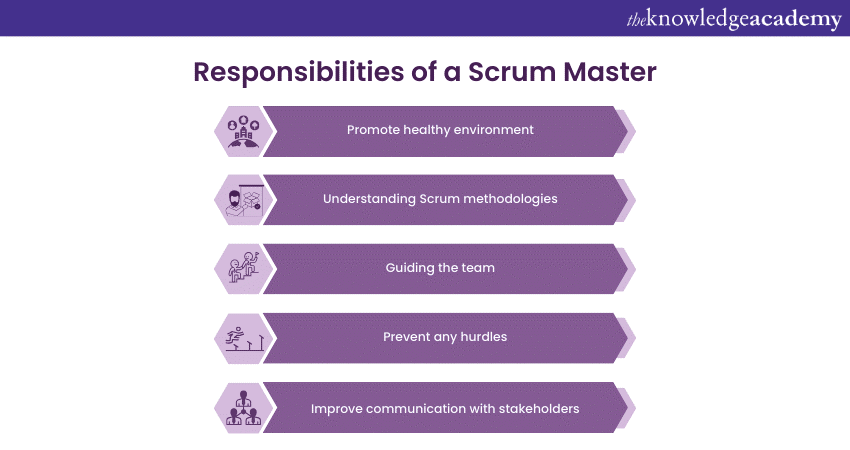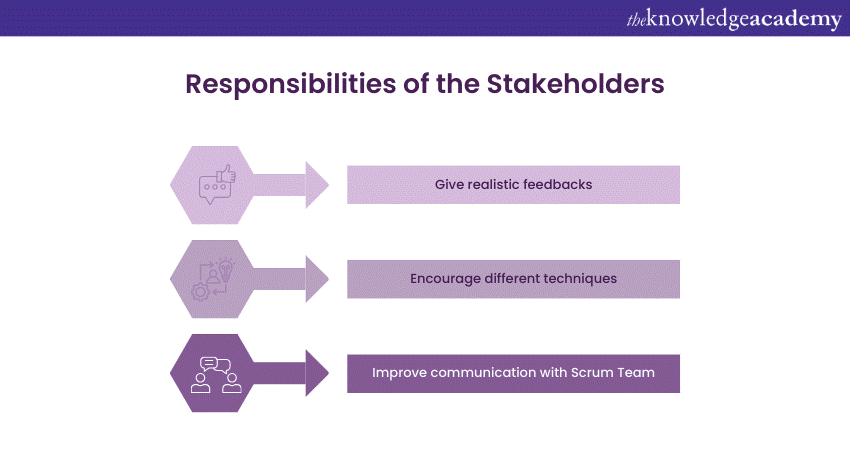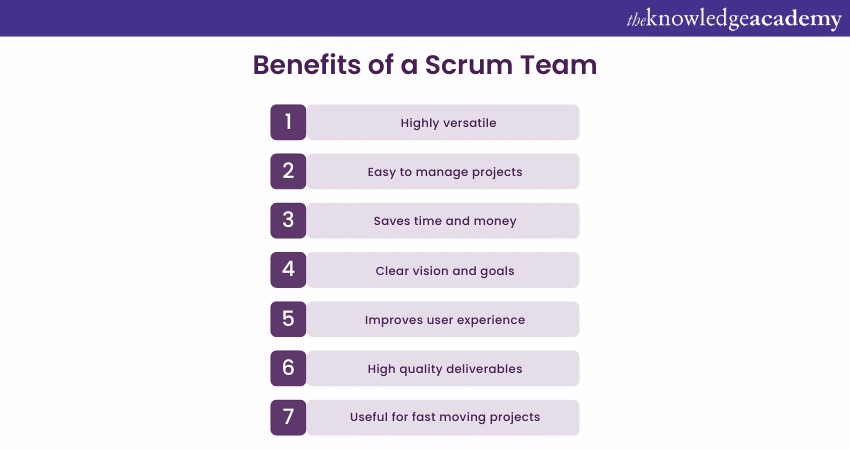We may not have the course you’re looking for. If you enquire or give us a call on 01344203999 and speak to our training experts, we may still be able to help with your training requirements.
Training Outcomes Within Your Budget!
We ensure quality, budget-alignment, and timely delivery by our expert instructors.

Modern-day organisations are often met with complex projects. That is why they adopt frameworks like Scrum. But mere implementation of the framework isn’t enough, organisations must also have strong teams in place to make a project successful. Therefore, they must learn What is a Scrum Team.
According to the State of Agile Report, 87% of Agile teams globally use Scrum. The Scrum framework encourages teamwork and promotes stakeholder participation. However, if you are still unsure of how this team works or are looking to turn your team into a Scrum Team, this blog is for you. Read this blog as we explore What is a Scrum Team in detail. We will also discover the roles and responsibilities involved within the team, along with their benefits. So, let’s delve in!
Table of Contents
1) What is a Scrum Team?
2) Scrum Team roles and responsibilities
3) Benefits of a Scrum Team
4) Conclusion
What is a Scrum Team?
Scrum Team is a multidisciplinary team consisting of individuals with different expertise that may include developers, designers and testers. Led by Scrum framework, they handle the work in a collaborative manner to deliver valuable work increments during the Sprints that last for short periods of time.
A Scrum Team typically has a Scrum Master, a Product Owner, Developers and Stakeholders. What is special about these teams is that there is no pecking order, and everyone works towards a common goal. The Scrum approach is very similar to that of the Agile Manifesto, and the latter consists of 12 principles that can help software developers work effectively.

Roles and responsibilities of Scrum Team
Some key Scrum Team roles are shared and team members have fixed responsibilities regardless of the project type. As for the other members, the Scrum Team's roles and responsibilities may vary for individuals. However, they all work collectively towards the goal of completing the project.
Some Scrum Team members may have unique skill sets and certifications that make them more qualified for certain Scrum Roles. These skilled members will coordinate with each other to overcome any issues, boost morale, and increase product quality. Some of the key roles in a Scrum Team are as follows:
Scrum Master
The Scrum Master is the captain of a project. In most cases, a Scrum Team would have only one Scrum Master. They usually have deep knowledge of the framework because of their extensive experience or through certification.
They will guide other team members using their knowledge and proficiency. They keep an eye on the whole team at each step and guide them along the way. The following are some responsibilities of the Scrum Master:

a) Promoting a healthy work environment for the team where everyone can collaborate easily
b) Cognisance of the project management methodologies like Scrum and Agile
c) Guiding the team in using the Scrum framework and other principles
d) Protecting the team members from any hindrances that could affect the work
e) Keeping a healthy bond between the client and individual team members
Sign up for our Scrum Overview Course and learn about the basics of Scrum framework!
Product Owners
Product Owners are experts in overseeing the development team. A Scrum Team usually has only one Product Owner, similar to a Scrum Master. They oversee and examine all the decisions in a project so that they are on par with the team's goals. They have extensive knowledge of business procedures and client-centric approaches. Some of the responsibilities of the Product Owners include:
a) Creating a purpose for the product and developing a strategy for increasing sales
b) Tracking the user experience of the customer and their needs
c) Enhancing the team's strategy to improve the product's worth
d) Working on Project Backlog
e) Making suggestions and adjustments to improve the project turnover with proper examination
f) Meticulously work on new ideas to solve any problem and take charge of the situation
Developers
The development team comprises people involved in writing codes and developing the product. These people are highly skilled and can coordinate well with others. They are experts in solving problems in a structured way and can manage their time efficiently. With these skill sets, they can create a superior product that is refined at every sprint. Some of the roles and responsibilities of the development team include the following:
a) Coming up with a realistic approach to Project Backlogs
b) Focusing on the team's goals and prioritising teamwork rather than on the pecking order
c) Taking the initiative and responsibility for the successful completion of the project
d) Ability to use a multifunctional approach so that they possess the necessary knowledge to finish the project
e) Dispatching finished projects within the estimated schedule
Contributors or Stakeholders
Stakeholders are the final piece of the puzzle for the Scrum Team. They are not considered an essential part of the team because they are not involved in developing the product. Anybody who invested in the project or has a vested interest in completing the project is called a Stakeholder.
Although they are not Directly involved in product development, they play an active role by giving feedback. This feedback can potentially change the project's result. Some of the responsibilities of the stakeholders include the following:

a) Giving realistic suggestions on how to improve the products
b) Giving motivation to try on different procedures to achieve the project's goals and result
c) Stakeholders need to communicate with the members of the Scrum Team, like the Scrum Master and Product Owner to make way for the product functionality
Signup for our course on Scrum Developer Training and enhance your project management skills!
Benefits of a Scrum Team
The following are of the benefits of having a Scrum Team during Project Development Lifecycle:

a) It is very versatile, and you can use it to manage projects in any industry
b) It makes Project Management simple by dividing large projects into manageable Sprints
c) It saves a lot of time and money since projects are completed efficiently and effectively
d) Everyone on the team will have a good understanding of the projects with the help of meetings
e) The contributions of all the Scrum Team members are discussed at the team meetings
f) It focuses on continuous refinement and will work on feedback from clients and project contributors
g) The process of receiving and working on feedback is also simple since it is received on short Sprints
h) The final product will be of high quality and more likely to meet the customer's expectations due to the changes based on the feedback
i) Feedback and changes are implemented almost immediately, thus proving useful for large-scale and fast-moving projects
Conclusion
This blog walked you through,What is a Scrum Team and how it can help you in Project Management. . Most importantly, it discussed the roles involved within this team and their responsibilities. We hope this blog gave you the relevant insights you were looking for and wish you luck on your journey with your team!
Learn about using different techniques of Scrum Master their responsibilities by signing up for our Scrum Master Certification Course now!
Frequently Asked Questions

A Scrum team is a specific type of Agile team that follows the Scrum framework, which includes defined roles, events, and artifacts. Agile teams, more broadly, may use various Agile methodologies like Kanban or Lean, and have more flexibility in how they organize their processes and structure.

a) Clear Goals: Set clear goals at the start of each sprint.
b) Collaboration: Foster a collaborative environment where team members can share ideas and solve problems together.
c) Short Sprints: Keep sprints time-boxed for regular progress updates and adaptability

The Knowledge Academy takes global learning to new heights, offering over 30,000 online courses across 490+ locations in 220 countries. This expansive reach ensures accessibility and convenience for learners worldwide.
Alongside our diverse Online Course Catalogue, encompassing 17 major categories, we go the extra mile by providing a plethora of free educational Online Resources like News updates, Blogs, videos, webinars, and interview questions. Tailoring learning experiences further, professionals can maximise value with customisable Course Bundles of TKA.

The Knowledge Academy’s Knowledge Pass, a prepaid voucher, adds another layer of flexibility, allowing course bookings over a 12-month period. Join us on a journey where education knows no bounds.

The Knowledge Academy offers various Scrum Certification Training, including Scrum Master Certification Training, Scrum Developer Training, and Scrum for Teams course. These courses cater to different skill levels, providing comprehensive insights into Scrum Tools.
Our Project Managment Blogs covers a range of topics related to Scrum, offering valuable resources, best practices, and industry insights. Whether you are a beginner or looking to advance your Scrum skills, The Knowledge Academy's diverse courses and informative blogs have you covered.
Upcoming Project Management Resources Batches & Dates
Date
 Scrum Master Certification
Scrum Master Certification
Thu 9th May 2024
Thu 23rd May 2024
Thu 30th May 2024
Thu 6th Jun 2024
Thu 13th Jun 2024
Thu 20th Jun 2024
Thu 27th Jun 2024
Thu 4th Jul 2024
Thu 18th Jul 2024
Thu 25th Jul 2024
Thu 1st Aug 2024
Thu 8th Aug 2024
Thu 15th Aug 2024
Thu 29th Aug 2024
Thu 5th Sep 2024
Thu 19th Sep 2024
Thu 26th Sep 2024
Thu 3rd Oct 2024
Thu 10th Oct 2024
Thu 17th Oct 2024
Thu 24th Oct 2024
Thu 31st Oct 2024
Thu 7th Nov 2024
Thu 21st Nov 2024
Thu 5th Dec 2024
Thu 19th Dec 2024







 Top Rated Course
Top Rated Course


 If you wish to make any changes to your course, please
If you wish to make any changes to your course, please


